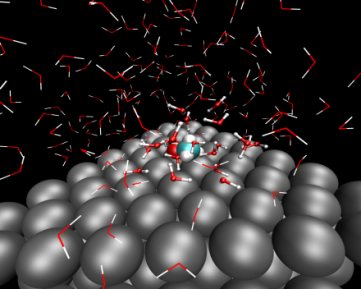Catalysis-

source : http://faculty.chem.queensu.ca
CATALYSIS-
” Catalyst is a substance which increases or decreases (alters) the rate of reaction & remains unchanged chemically at the end of the reaction. Such a phenomenon where the rate of a chemical reaction is either increased or decreased is known as catalysis.
Classification of Catalysis-
I-Based upon the physical states of catalyst & reactants
a) Homogeneous Catalysis-
If the physical state of the catalyst & reactants is the same,then catalysis is known as homogeneous catalysis
Ex.
(1) In lead-chamber process for the manufacture of H2SO4, the physical state of reactants & catalyst is same i.e. gas.
2SO2 + O2 + (NO) ——>2 SO3
(gas) catalyst (g)
2) Heating of KClO3
.2KClO3 + (MnO2) ——–> 2KCl + 3O2 + (MnO2)
(s) (s)
3) Hydrolysis of Ester-
CH3COOC2H5 + H2O + [H2SO4]——–> CH3COOH + C2H5OH+ [H2SO4]
(l) (liquid) (l)
b) Heterogeneous Catalysis-
If the physical state of the reactants & catalyst are not same then the process is known as heterogeneous catalysis.
Ex. 1. In Haber’s process of manufacture of NH3, Fe is used as catalyst.
N2(g) + 3H2 (g)———-> 2NH3
2. Manufacture of H2SO4 by contact process-
2SO2 +O2 ![]() 2SO3
2SO3
(g) (gas) catalyst
3. Manufacture of vegetable ghee from vegetable Oil
Vegetable oil + H2 ![]() Vegetable Ghee
Vegetable Ghee
(liquid) (g) catalyst(s)
II- Classification based upon the action of Catalyst-
a) Positive Catalysis-
If catalyst increases the rate of a reaction then catalyst is known as the positive catalyst & the phenomenon is known as the catalysis.
Ex.
1: Decomposition of KClO3 is increased by MnO2, therefore MnO2 is a positive catalyst.
2KClO3 + [MnO2] ——> 2KCl + 3O2 + [MnO2]
2. Manufacture of HNO3 by ostwald’s methods
NH3 + O2 +[Pt]——–> NO+H2O + [Pt]
3. Manufacture of NH3 by Haber Process
N2 +3H2 +[Fe] ——-> 2NH3 + [Fe]
4. Manufacture of H2SO4 by contact process
2SO2+O2+[Pt or V2O5]——–> 2SO3 + [Pt or V2O5]
5. Inversion of cane sugar
C12H22O11 + H2O +[dil.H2SO4]——-> C6H12O6(glucose)+C6H12O6(fructose) + [dil.H2SO4]
b) Negative Catalyst-
If a catalyst decreases the rate of a reaction then catalyst is known as negative catalyst & phenomenon is known as negative catalysis.
Ex.
1. Chloroform reacts with O2 in presence of sunlight & forms phosgene gas(COCl2) which is poisonous. To prevent this reaction CHCl3 is kept in coloured bottles & small amount of C2H5OH is added which acts as negative catalyst.
CHCl3 + O2——–> COCl2 + HCl
phosgene
C2H5OH + COCl2———> (C2H5)2CO3+HCl
nonpoisonous
2. The rate of decomposition of H2O2 can be decrease by adding small amount of Acetanilide or H3PO4 or glycerine. These substances act as a negative catalyst.
3. TEL (Tetra ethyl lead) acts as an anti knocking compound . It decreases knocking property of petrol therefore acts as negative catalyst.
c) Auto Catalysis-
When one of the products of a chemical reaction acts as a catalyst , then phenomenon is known as auto catalysis. and product which acts as catalyst is known as auto catalyst.
Ex.1 : Oxalic acid reacts with KMnO4 in acidic medium as follows
2KMnO4 + 3H2SO4 +( COOH)2—–> K2SO4 + 2MnSO4+ 10CO2+4H2O
The Pink colour of KMnO4 disappears during this reaction. Mn++ obtained in the reaction acts as catalysts.Hence it increases the rate of reaction. The pink colour of KMnO4 disappears slowly in the beginning but as the reaction progresses, & more Mn++ are formed. Thus pink colour of KMnO4 disappears at a faster rate. Therefore Mn++ acts as auto catalyst.
2. Hydrolysis of Ester
CH3COOC2H5 + HOH——> CH3COOH+C2H5OH
acetic acid acts as auto-catalyst
d) Induced Catalysis-
If two chemical reactions are taking place together & one of these reactions is catalysing the other reaction & phenomenon is induced catalysis.
Ex.1 Oxidation of sodium arsenite by air is very slow while oxidation of Na2SO3 in aq. Solution by air takes place at a reasonable speed. If aqueous solution containing both these compounds is oxidised by air then oxidation of both compounds take place at reasonable speed. The oxidation of sodium sulphate is catalysing the oxidation of sodium arsenite.
2Na2SO3+O2——-> 2Na2SO4
2Na3AsO3 +O2——-> 2Na3AsO4
Ex.2. The reaction of HgCl2 & oxalic acid is very slow. The reaction of KMnO4 & oxalic acid in acidic medium proceeds at a reasonable speed. If both of these reactions are carried out together then both will proceed at a reasonable speed. The reaction of KMnO4 & oxalic acid catalyses the reaction of HgCl2 & oxalic acid.
Read more articles at chemistryonline.guru







